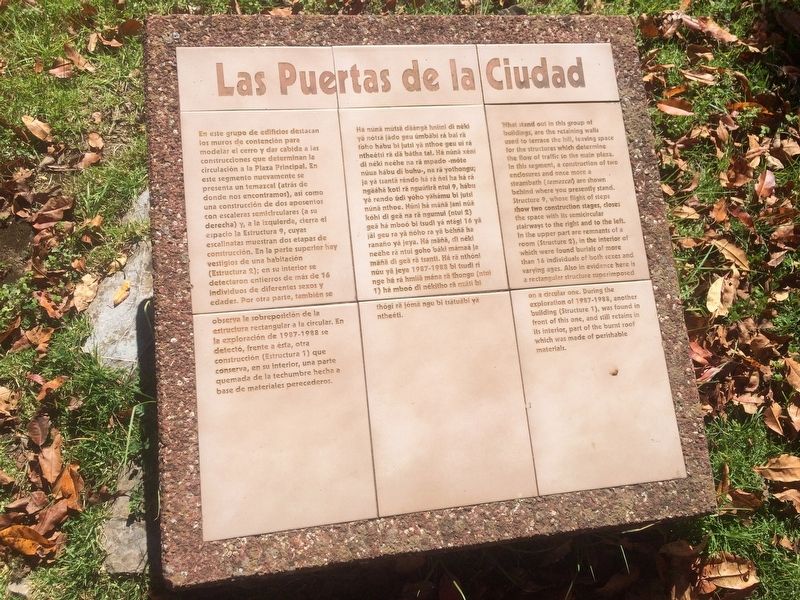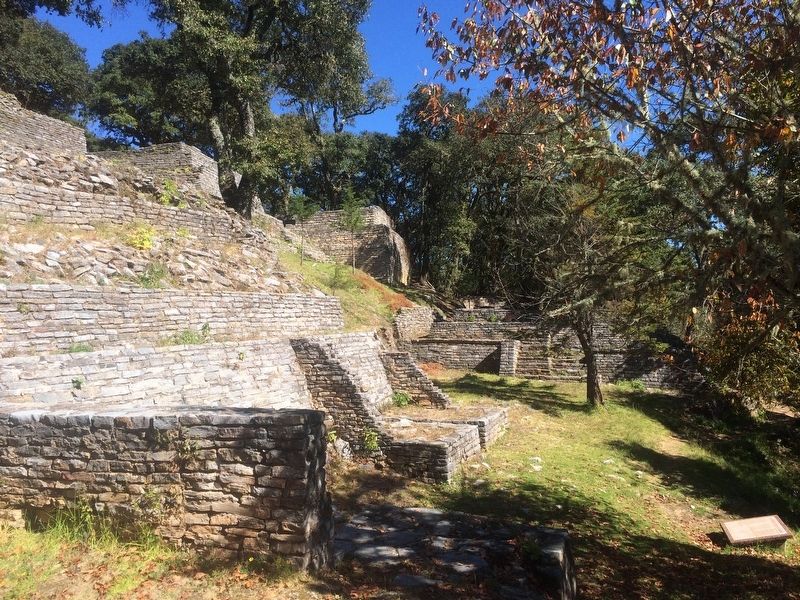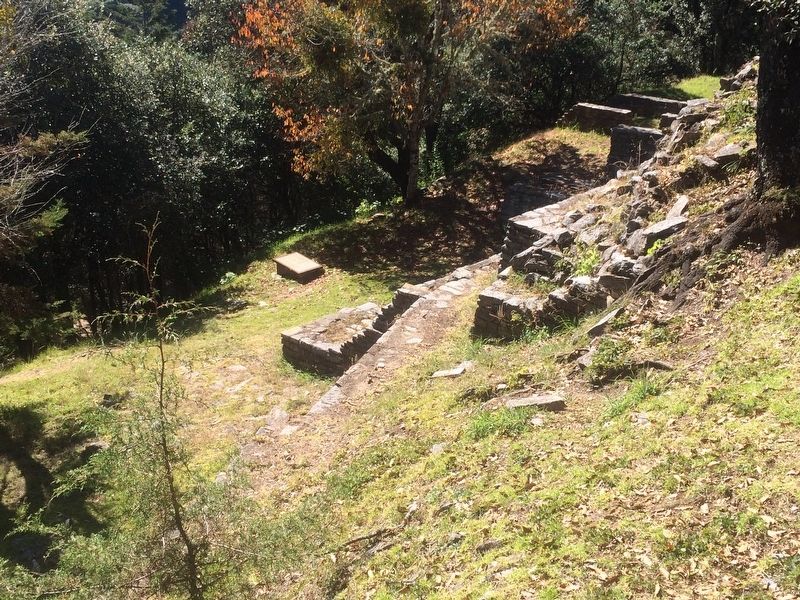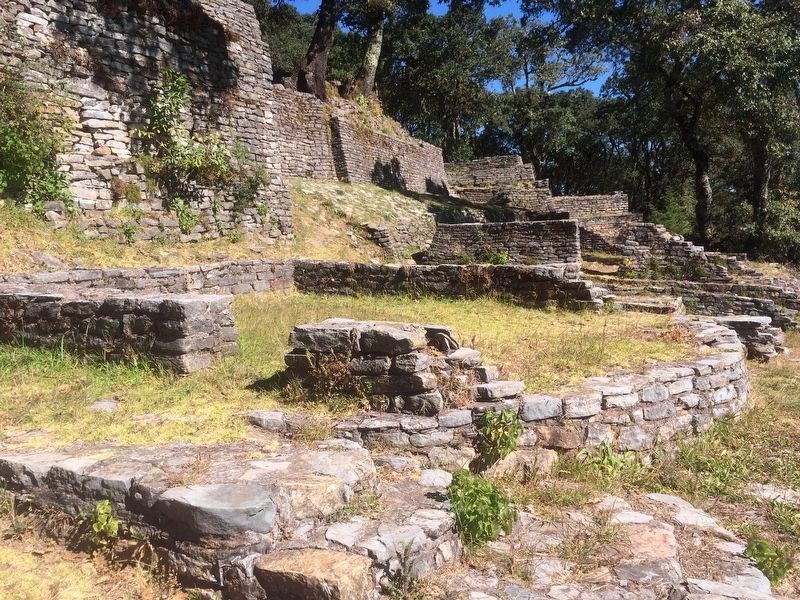San Joaquín, Querétaro, Mexico — The Central Highlands (North America)
The Doors of the City
Las Puertas de la Ciudad
En este grupo de edificios destacan los muros de contención para modelar el cerro y dar cabida a las construcciones que determinan la circulación a la Plaza Principal. En este segmento nuevamente se presenta un temazcal (atrás de donde nos encontramos), así como una construcción de dos aposentos con escaleras semicirculares (a su derecha) y, a la izquierda, cierra el espacio la Estructura 9, cuyas escalinatas muestran dos etapas de construcción. En la parte superior hay vestigios de una habitación (Estructura 2); en su interior se detectaron entierros de más de 16 individuos de diferentes sexos y edades. Por otra parte, también se observa la sobreposición de la estructura rectangular a la circular. En la exploración de 1987-1988 se detectó, frente a ésta, otra construcción (Estructura 1) que conserva, en su interior, una parte quemada de la techumbre hecha a base de materiales perecederos.
Las Puertas de la Ciudad
Ha nuna mútsä däánga hniini di néki yä notsä jado geu úmbäbi rá bal rä toho habu bi jutsi yä nthoe geu ui rá ntheétsi rä dä bátha tal. Há núna xéni di néki neéhe na rä mpado –móte núua hábu di buhu-, na ra yothongu; ja yá tsantä réndo há rá ñei ha há rá ngäáhä koti rä nguútirä ntui 9, hábu yá rendo údi yoho yähámu bi jutsi núna nthoe. Núni há mäñä jani núä kóhi di geä na rä ngumui (ntui 2) geä há mboó bi tsudi yá ntági 16 yä jäi geu ra yä nóho ra ya béhnä ha ranaño yá jeya. Há mäñä, di néki neehe rä ntui goho báki mámaá ja mäñä di gea rä tsanti. Há ra nthóni núu yä jeya 1987-1988 bi tsudi rí nge ha rá hmlia mána rá thongu (ntui 1) há mboó di nékitho ra mzäti bi thógi rä jómä ngu bi tsätuäbi yä ntheéti.
The Doors of the City
What stand out in this group of buildings, are the retaining walls used to terrace the hill, leaving space for the structures which determine the flow of traffic to the main plaza. In this segment, a construction of two enclosures and once more a steambath (temazcal) are shown behind where you presently stand. Structure 9, whose flight of steps show two construction stages, closes the space with its semicircular stairways to the right and to the left. In the upper part are remnants of a room (Structure 2), in the interior of which were found burials of more than 16 individuals of both sexes and varying ages. Also in evidence here is a rectangular structure superimposed on a circular one. During the exploration of 1987-1988,
another building (Structure 1), was found in front of this one, and still retains in its interior, part of the burnt roof which was made of perishable
materials.
Erected by Instituto Nacional de Antropología e Historia (INAH).
Topics. This historical marker is listed in these topic lists: Anthropology & Archaeology • Architecture • Man-Made Features • Native Americans.
Location. 20° 55.57′ N, 99° 33.921′ W. Marker is in San Joaquín, Querétaro. Marker is on Unnamed Road. The marker is at Ranas Archaeological Site to the north of the town of San Joaquín, on an unnamed but well-known road, near the "Finca de Doña Lore". Touch for map. Marker is in this post office area: San Joaquín QUE 76550, Mexico. Touch for directions.
Other nearby markers. At least 8 other markers are within walking distance of this marker. The City and its Territory/The Inhabitants (within shouting distance of this marker); The Sunken Patio Complex (within shouting distance of this marker); The Buildings 16 and 16-b (within shouting distance of this marker); Archaeological Work (within shouting distance of this marker); Building Three (within shouting distance of this marker); Ball Court Three (about 90 meters away, measured in a direct line); Las Ranas and the Access Complex
(about 90 meters away); Ball Court Two (about 210 meters away). Touch for a list and map of all markers in San Joaquín.
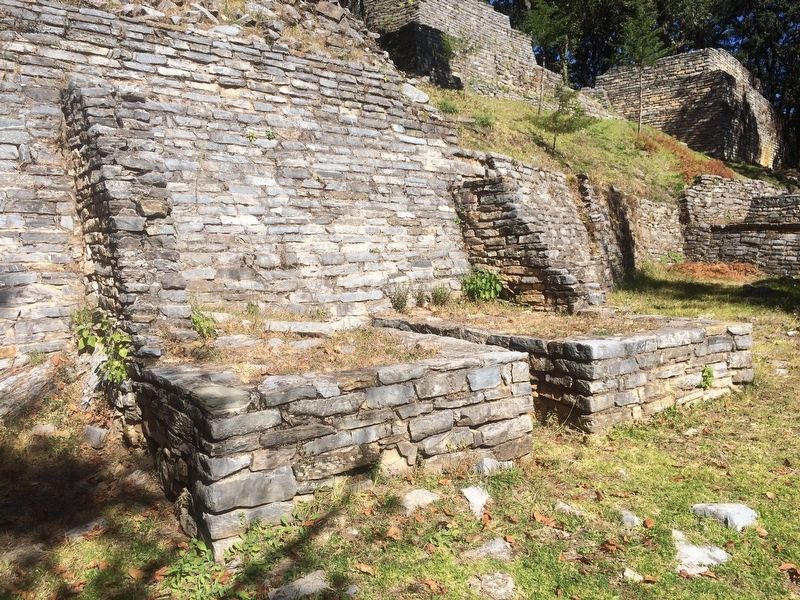
Photographed By J. Makali Bruton, December 9, 2017
4. Remains of a steambath just behind the marker
As the marker mentions, these are probably the remains of a steambath, or 'temazcal'. The structure was probably covered by a roof made of perishable materials. Note the passageway left between what were probably the stone 'seats' inside of the steambath.
Credits. This page was last revised on January 23, 2018. It was originally submitted on January 21, 2018, by J. Makali Bruton of Accra, Ghana. This page has been viewed 114 times since then and 7 times this year. Photos: 1, 2, 3, 4, 5. submitted on January 21, 2018, by J. Makali Bruton of Accra, Ghana.
